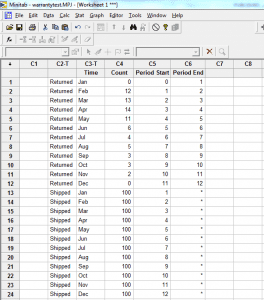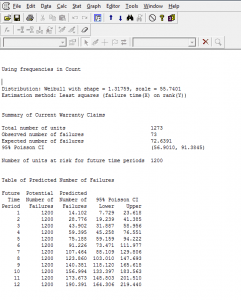This of course, is assuming you have historical data for the future analysis. For example, how do you figure out what the warranty prediction will be if you have never shipped product? Setting a 20% failure in the first year is high as most product designs strive to keep this number at 2% or lower, but by setting this failure rate, you are positioning your product for the consumer market. 20% returns in a consumer market is not unheard of and probably 60-80% of those returns are not defect-related, but I digress.
Let’s suppose you have some historical returns data. You\’ve shipped 100 units per month for a total of 1200 units shipped in one year with 73 returns. Minitab allows you to enter the number of returns per month, will offer you a warranty model for future periods. Remember that this will be for future periods.
So whatever failure rates you have for the first twelve months, the future period will highlight the number of failures for the next twelve months. If you intend to offer a 24 month warranty, then you must factor in the year 1 costs and the future year 2 costs.
In this example, it\’s estimated that by the end of the 24 month period (future 12 month period) 263 returns would be expected on 2400 units shipped. Let’s break this down: 1200 units are shipped for each year with a total of 2400 units shipped in two years. 73 units are returned in year 1 and 190 returns are expected in year 2. 263 units returned on 2400 units shipped would suggest 10.9% return rate over two years.
After analyzing the actual returns, consider whether there are design or documentation improvements to better demonstrate how the product should work, thus reducing the number of returns.




Be the first to comment